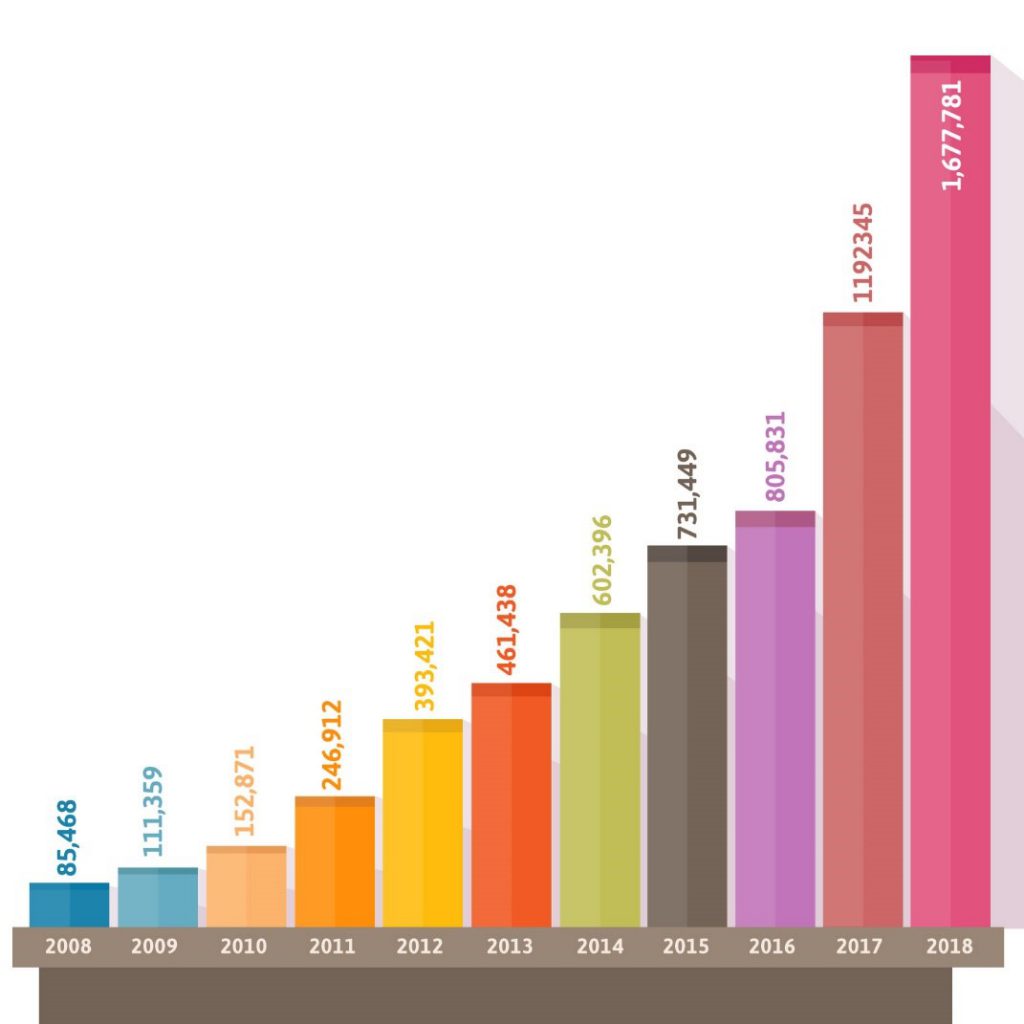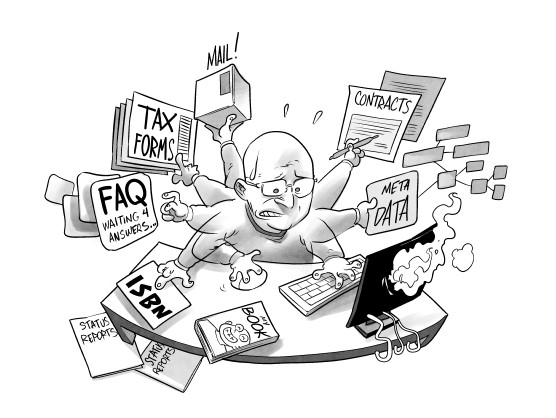Why “Vanity Publisher” Is an Outdated Misnomer
By Tim Lindsay, Founder & CEO of Tellwell
You’ve written your book! Congratulations on such a significant accomplishment. So many people start, but so few finish! Moreover, the book you’ve written is good (you don’t tell many people this, but it’s way better than you thought it would be). It’s so good, in fact, that you know you need to take the next step and find a way to publish.
If you begin researching book-publishing options online, it’s possible you’ll read about the exciting growth and accessibility of self-publishing—the “indie publishing” revolution that has democratized access to publishing. You may read about “authorpreneurs” taking control of publishing timelines, bypassing the old gatekeepers, earning higher royalty rates, and building intimate and direct relationships with readers. Exciting, right?
But then the term “vanity publisher” also shows up in your search results, making you pause, since the term vanity carries with it pejorative connotations. Wait a second . . . should you be ashamed to self-publish? Is self-publishing “vanity publishing,” or is it legit? And if self-publishing is indeed a credible option, is it possible to get help, or must you do literally everything yourself?
It turns out that the term “vanity publisher” is most often used by people who don’t understand the history and nuances of the current publishing landscape. The term has become outdated insofar as:
- Advances in technology have strengthened the advantages of self-publishing while eliminating many of its drawbacks.
- It obfuscates objective analyses of the pros and cons of each publishing model, implicitly minimizing the downsides of the traditional publishing model.
- It confuses and conflates four approaches to self-publishing—a complete DIY approach, a DIY-freelancer model, hybrid, and assisted self-publishing—without properly elucidating the pros and cons of each from the standpoint of different types of authors.
The term is also toxic in that it harms authors and discourages those who have the passion and skill to help them: editors, graphic designers, illustrators and others.
Finally, the term is just plain wrong in ascribing “vanity” as a motive based on the publishing business model, rather than looking at the facts of what motivates people to write and publish. Self-publishing is now the smarter option for many authors, and their motivations to write and publish their works are amazingly rich and diverse.
The remedy to the misuse of the “vanity publisher” term is to properly understand the bigger picture: the advantages and disadvantages of each publishing model. Let’s get started.
What is a vanity publisher?
Historically, the term referred to businesses offering to publish your book in exchange for payment, typically involving a large order of books, no access to distribution, with the publishing company taking the publishing rights even though the author funded the project. Companies such as Dorrance Publishing (founded in 1920) and Vantage Press (founded in 1949, closed operations in ceased business in 2012) are sometimes pointed to as examples. However some people have used the term to refer to all self-publishing projects where the author pays for support, implying that authors who dared to strike out and finance the publication of their own book, independent of the traditional gatekeepers, were vain.

Of course, this was before major technological changes spurred rapid growth in self-publishing, creating more advantages and fewer downsides, as discussed below.
Nowadays the term is used inconsistently. Some people incorrectly use the term to refer to self-publishing in general. Most people now distinguish between vanity publishing and self-publishing, but the precise definitions vary. The Science Fiction and Fantasy Writers Association draws a clear distinction between assisted self-publishing companies and vanity publishers. They describe assisted self-publishing companies as offering publishing services such as formatting, cover design, sales and distribution with non-exclusive contracts that are terminable by the author at will. In contrast they describe vanity publishers as falsely presenting themselves as traditional publishers and contracting rights on an exclusive basis.
In the new publishing landscape, any “vanity” in publishing could just as easily be surmised to exist in a subsection of the traditional or hybrid publishing models: an author accepts objectively poor publishing deals with little or no advance payment, low royalties, and a poor rights deal in exchange for the ability to say they are traditionally published—thereby conveying an illusive sense of prestige.
Every publishing model has its critics. To understand how the term “vanity publisher” is misused and outdated, your understanding of the downsides of self-publishing—most notably that the author must finance the project—must be counterbalanced with an understanding of the downsides of alternative publishing options.
The good news is that, once you understand that every option has its downsides, you can change your perspective and focus on the positive sides of each of them. Publishing a book is more accessible and there are better options now than ever before. The real question is which option is best for you.
Is traditional publishing a good option?
In the traditional publishing model, a writer signs with an agent, who acquires a publishing deal for the writer’s work. This usually involves the publisher giving the writer an advance payment against future royalties. In exchange, the author signs over rights to their book. The publisher then produces the book and offers it on the market.
Is there anything inherently wrong with this model? Not at all. It’s great for some authors, especially if they get a substantial and fair advance in a timely manner. But as with every option, it has drawbacks.
When writers offer criticisms of the traditional publishing model, they are usually concerned with one or more of these ten perceived shortcomings:
- Small royalty advances—or none at all—and low royalty rates
- Lengthy publishing timelines—often one to three years
- Loss of creative control
- Loss of copyright and ancillary and subsidiary rights
- High printing costs for author copies, with no option to print elsewhere
- The author is occasionally asked to rewrite significant portions of their work, or finance their own editing, prior to manuscript consideration
- An interest only in profits from the publisher, who is unwilling to consider niche audiences or take risks on unknown authors
- Limited or nonexistent marketing efforts, with the publisher refocusing quickly on their next book or more popular titles, leaving the lion’s share of the long-term marketing efforts to the author, even though most sales revenue goes to the publisher
- The lengthy sales process writers must go through to get an agent
- The myriad boilerplate rejection letters typical of the process of soliciting agents and publishers, and associated wait times—often three to six months each.
Charles Dickens was so upset with his traditional publishers that he originally published A Christmas Carol on his own. In those days, self-publishing meant printing a large volume of books on your own dime, then trying to figure out how to sell them.
Prolific American sci-fi and fantasy writer Dean Wesley Smith wrote over 200 novels, working with traditional publishers for the first hundred or so. But he has since written numerous scathing critiques of the model. He likens traditional publishers to payphones and dial-up modems from the last century: completely outdated, unfair, and a bad choice for most authors. He embraced an indie approach for his next hundred or so books.
None of the above should diminish the amazing work done by many traditional publishers and the great service and experiences they provide to writers and readers. It simply highlights that every model has its downsides and its critics. Not every author is given the celebrity treatment when going the traditional publishing route. Sometimes the grass looks greener than it is.
Is self-publishing legitimate?
Self-publishing gained credibility when the publishing industry changed dramatically in recent decades due to three technological innovations: print-on-demand, E-commerce, and ebooks. These changes eliminated many of the old pitfalls of self-publishing, such as the requirement of printing large quantities of books without access to sales channels. Now an author can sell their books online using print-on-demand services without producing a single advance copy. Companies such as Ingram Content Group linked print-on-demand books directly into their vast network of online sales channels. Self-published books were now listed on Amazon and other online retailers alongside traditionally published books. And consumer behaviour underwent a fundamental change, with the public becoming increasingly comfortable ordering books online. Authors could now sell ebooks too, increasing potential profits.
When compared to the traditional publishing model, the advantages of self-publishing started to stack up:
- Quick access to market
- High royalty rates
- Creative control
- Rights retention
- No large upfront printing costs required
- The option to publish for free, or—for authors caring about quality—to pay for as much or as little support as needed
The result was predictable: a surge in authors opting to go with this new version of self-publishing, many not even bothering to consider the old way.

As a consequence, the term “vanity publisher” no longer held much relevance in this new publishing landscape. Self-publishing has become a legitimate alternative to the traditional publishing model. For most authors, it was the more appealing option.
At Tellwell, we survey authors before helping them with marketing. One question we ask is, “Why did you choose to self-publish your book?” Here are the reasons why twelve authors, in their own words, chose to self-publish:
- It was the simplest way to proceed in the shortest amount of time. Trying to find a publisher could take years. – B. Kennedy
- To keep full control of content and design. – M. Porter
- Seemed like the best & easiest way to have full say over my book’s life from beginning to end. – J. Sousa
- Not many agents want to represent a newbie, so I decided to self-publish to hopefully get my foot in the door. – K. Marchand
- It was the quickest way to get my book published while still working with a publisher. – L. Rakos
- I would prefer to keep my rights to all my work. – O. Rose
- After doing some research and familiarizing myself with the various ways to get published, I felt that the freedom involved with self-publishing was more appropriate for me. – L. Arseneault
- I wanted to have it done rather than wait for someone to like it. I switched publishers because the last experience was unreliable and I lost control of my work as well as revenue. – M. Mattaliano
- Writing this story was a personal creative goal. Self-publishing has been an easy and positive learning experience. – J. Renieris
- Because I am not primarily working for money. – K. Chong
- I want more of the royalties because of my extensive research and lengthy time spent on this work. – T. Tibando
- My reasons for self-publishing: i) follow my own timeline, ii) control my story and platform, iii) higher royalties, iv) the time is right, v) either way, marketing is up to me, and vi) I believe in myself. – B. Mkwelele
If any of the above resonate, you are in good company and might be a good candidate for self-publishing.
Do you have to pay to publish your book?
It is now theoretically possible to publish a book for free. Great! Or is it? While that might sound nice, it could also be a recipe for a disaster: low-quality books are upsetting to readers and book buyers. Traditional publishers could publish books for free too, but they never would. Producing a quality book requires investment. Otherwise, readers might buy a book only to find it riddled with spelling errors, consequently ripping into it with bad reviews and ruining the brand of the publisher. The cover might look so amateurish that nobody would consider buying it in the first place.
There’s an important, contradictory nuance here that’s worth highlighting. Some people use “vanity publisher” as a derogatory slur towards a subset of self-publishing authors, namely those who pay for help, and anyone who tries to help them. But using the term in this manner slanders authors who care about quality. To suggest that everyone ought to take an absolutely DIY approach to every aspect of publishing is simply bad advice, and certainly not best practice.
As success stories started to emerge amongst self-published authors, the common interview question, “What advice do you have for authors who self-publish?” started to yield predictable answers: “Never skimp on editing,” and “Be sure to invest in a professional cover design.” In short: don’t do everything yourself! A hardcore DIY approach to self-publishing might be right for some people, especially those with no budget. But it is not for people who care about quality and want to avoid the headaches and hassles of doing everything themselves.
Choosing to self-publish doesn’t mean your book can’t rival or surpass the quality of many traditionally published books, but quality always comes with costs. The real questions become whether that cost is fair and the services worth the investment—questions that each person might answer differently—and whether the service provider is reputable and delivers on what they promise.
The real reasons people write and publish books
Whether a book is worth publishing requires an understanding of the reasons people write books, and—spoiler alert—it’s not solely about profit or ego. Of all the ways people can spend their time in this world, writing and publishing a book is hardly synonymous with vanity. It is one of the more meaningful and creative pursuits.
The term “vanity publisher” is inaccurate in that it implies a mistaken motive for publishing. People looking to publish a book are often accomplished individuals, the sort of people who set goals and achieve them. Many have done their research, understand the pros and cons of all their publishing options, and choose to self-publish. They want to make every effort to produce a quality product.
But what is their real motivation to publish? The answers, it turns out, are as diverse as humanity.
At Tellwell, another survey question we ask authors is, “Why did you write your book?” Here is a small sampling of responses:
- To celebrate my love of family, friends, neighbours and life. – H. Van Berkel
- I wrote the book as a tribute to the courage of my fearless and glamorous mom. – T. Schnurmacher
- I present many speeches throughout the year. I am always asked if I have a book the audience can take home. Now I do! – A. Lane
- I wrote this book with the intent of healing and giving abused children a voice, no matter how old they are now. – C. Cunliffe
- It’s a memorial piece for my dad. In illness I realized the importance of preventive nutrition. The book teaches children about how much sugar content is in food. – Maria S.
- To help HR students and professionals hone and elevate their employee-relations skills. – A. Champ
- Inuit culture is wonderful. I value sharing stories from my culture. – N. Batzel
- I wrote this book because strategy is my passion and I thought that there was much missing from what is taught in business schools. – P. Sacco
- To help women advance at work. To help close the gender gap in wages and leadership, and to allow women access to my seminar material. – D. Fromm
- To give back to the cancer-care community that made me who I am today. – R. Stourac
- To prove to those with learning disabilities that they are not alone in their struggles. No matter how the world treats us, we will succeed in our endeavors. – J. Stewart
- To have fun. – R. Johnson
It’s our humanity, not vanity, that propels us to share our stories, to take on the challenge, often the lifelong goal, of publishing a book. The publishing business model that is best suited for an author has nothing to do with their motivation to publish.

So, let’s move past the misnomer “vanity publisher” and accept instead that there has been a dramatic change in the modern publishing world that has shifted the balance in favour of self-publishing. Let’s make room in our lexicon for current and relevant terms like “indie publishing,” “authorpreneur,” “publishing service provider,” “assisted self-publishing,” “a team approach,” or “a professional approach to self-publishing.”
Self-publishing is now widely celebrated for its advantages, especially for the control it gives to authors. The motivations to publish are rich, diverse, and meaningful. Indeed, perhaps it is the difficulty of writing and publishing a book that is part of what makes it meaningful, distinguishing the endeavor from other mediums of self-publishing such as tweets, social media posts, and blog articles. Anyone who sets the audacious goal of publishing a book and has the fortitude to follow through is deserving of great respect.
What about hybrid publishing?
There are good companies to work with who label themselves as “hybrid publishers,” who focus on a particular niche. But as this article is focused on how the unfairly pejorative label “vanity publisher” must be counterbalanced with the understanding that every option has both advantages and disadvantages, let’s look at the potential downsides of hybrid publishing.
- Low royalties bundled with upfront costs: Hybrid publishers charge authors up front for services and they take a portion of royalties, the worst of both worlds. Most self-publishing companies take revenue at both ends too.
- Disingenuous window dressing: The only real guarantee that a publisher will put any marketing effort into a book is the size of the advance they are willing to pay an author. If there is little or no advance payment, why would anyone believe there is real investment involved?
- Lack of transparency: Reputable companies have clear prices, a clear scope of services, and clear terms and conditions, something hybrid publishers often fail to provide up front, offering instead a business claim cloaked in secrecy, one that truly requires close scrutiny: that they are “sharing the cost” of publishing with the author.
Hybrid publishing doesn’t have the confidence to call itself self-publishing—or perhaps it is self-publishing with low self-esteem, trying to avoid the “vanity publisher” label rather than dismissing it as an outdated misnomer. If the author is financing the project then they are self-publishing, no matter what label is superimposed upon it. And there is nothing wrong with that.
The DIY-freelancer model of self-publishing
There is a version of the DIY approach that involves building a team of freelancers rather than working with an established publishing company. The model can work well for someone with great management skills, lots of time, and intimate knowledge of the publishing industry. In theory this model of self-publishing can give the author a lot of control. But in practice it has major downsides, such as:
- Excessive work by the author in recruiting, selecting, contracting, and supervising freelancers, keeping them on track, paying them, reviewing and/or writing contracts at every step, or risking misunderstandings
- Legal and tax-exemption paperwork with five or more distribution channels—or worse, not understanding how to correctly mix distribution channels to take advantage of their best features while avoiding their pitfalls (for example, Ingram has a good print-on-demand service, but their ebook distribution is poor, and their linkage to Amazon can be problem if you don’t know how to solve it).
- A lack of customer service, and the inability to respond to questions outside the scope of a freelancer’s specialty, which leads to frustrated freelancers who aren’t trained in or passionate about good customer service.
- A lack of structure in engaging each specialist—it is inefficient and expensive if the author and freelancer don’t know what information they need from each other at each step of the process.
- A lack of a holistic publishing view. For example, an illustrator or layout artist likely doesn’t understand which book dimensions and formats work for Ingram as compared to KDP Print, or the implications of this on distribution: whether the book will be listed as “in stock.” Nor can they effectively explain this to an author.
- It’s potentially expensive, especially if it’s your first time. Trying to learn the ropes while bringing together a team of experts can sometimes cost much more than working with an established team with a proven process.

Practitioners of the DIY-freelancer model will sometimes say that their model is “true self-publishing,” whereas working with an assisted self-publishing company is (you guessed it) vanity publishing. These online commentators often drastically underestimate the level of support and guidance that can benefit authors at each step. The DIY-freelancer model lacks the piece in the middle that ties everything together, relying instead on the author as project manager to singlehandedly fill that void.
But what if the author doesn’t want to take on the full burden of management alone? Enter assisted self-publishing companies, such as Tellwell, who argue that a balance needs to be struck between letting the publishing talent shine and do what they do best while empowering the author to remain in control of the project. Publishing is a team sport, and the relationship between the author and each specialist works best with a carefully mediated structure at each step.
Is Tellwell a vanity publisher?
No, Tellwell is not a vanity publisher. We reject the premise that authors who go the indie-publishing route, or those who support them, are deserving of such slander, given the well-established advantages of self-publishing. The Tellwell team provides publishing expertise and talent. We are editors who love editing, and we’re good at it. We are designers and illustrators with a passion for our craft. We are publishing professionals who genuinely enjoy the feeling of helping an author achieve a lifelong goal.
Tellwell takes away the legwork, the guesswork, and the false starts so often associated with self-publishing. We have a proven process of providing guidance at each step in just the right dosage through webinars, videos, individual phone calls, and printed guides. The transparent and supportive approach Tellwell offers from the outset eliminates the risk of unpleasant surprises. Tellwell provides experienced help to bring your book into the world with a professional sheen and a competitive edge, and the satisfaction of knowing you’ve done it yourself, and you’ve done it right.
We do this while remaining flexible—you don’t need to use all our services, just what you need. We have structured offerings to fit common needs, but we customize solutions for everyone before they begin. We don’t lock authors into captive pricing contracts for printing exclusivity.
The assisted-self-publishing model that Tellwell offers is transparent—we’re open with you about our process, pricing, and royalties and what is included in the scope of services, with clear terms and conditions that are fair. We leave you in the driver’s seat, retaining your copyright with your royalties in your pocket. It is a supportive and educational approach in which you maintain creative control: you write the briefs and you revise, finalize, and approve the content. Nothing is set in stone until you give it the go-ahead—we just give you the tools and professional talent you need to do it well.
The intricate path to publication is set out for you step by step, and includes support resources as well as one-on-one guidance from a project manager. The satisfaction of our 4,000 (and counting) authors speaks for itself: Tellwell has a Google rating of 4.5 out of 5, and our reviews on the Better Business Bureau have earned us 4.93 out of 5 stars. Read those reviews and you’ll get a clear picture of who we are.
Tellwell brings a unique perspective to the publishing industry characterized by three facets:
- We celebrate writers as authorpreneurs: smart people with diverse motivations, capable of taking informed risks to get their book on the market.
- We celebrate the role of the publishing team: editors, illustrators, designers, and other publishing professionals.
- We are great at tying all the pieces together into a holistic experience. This includes giving credit to the unsung publishing heroes who answer a stream of difficult publishing questions from authors and offer support and encouragement along the way.
Still, Tellwell’s self-publishing model isn’t for everyone. It is appropriate for authors who care about quality and are comfortable with the risk and costs involved. We are a uniquely good fit for authors who determine there is enough complexity in publishing a book to justify support. If you don’t have the budget or don’t perceive yourself as needing any help, it’s not a good model.
But perhaps the biggest downside of the assisted self-publishing model is the fact that many companies have failed to effectively manage and meet author expectations.
How do you know if a self-publishing company is legitimate?
Self-publishing as a whole is legitimate, and the assisted self-publishing model has unique advantages. Unfortunately, this doesn’t mean every service provider is equally reputable. Historically, some companies have done a poor job of delivering on their promises. That’s still the case today. Moreover, many companies have set up shop, delivered shoddy service, then quickly gone out of business. Worse still, there are outright scams out there. (To be clear, it is obviously not a scam to charge fair market rates for editing, illustrations, or other valuable services—people who argue this should be readily dismissed.)
While investigating self-publishing companies, do your due diligence. Be on the lookout for signs that they might be taking you for a ride. These include, but are certainly not limited to, the following:
- Promising high book sales. If they can do that, they should put their money where their mouths are and pay an advance.
- Making you feel insecure, or as though you have no options.
- Aggressive sales tactics before, during, or after publication.
- Requiring you to purchase physical copies.
- Having limited online visibility, such as few or no public reviews.
- Having no established social media presence.
- No terms and conditions with a clear scope of services.
- Lack of transparent pricing.
- Hidden costs.
- Insisting that they keep the copyright, without paying an advance.
- Not offering an option for you to retain 100% of your net royalties, or lacking transparency in how they calculate royalties.
- No clear complaints process, so they can correct course if something goes wrong.
- No evidence of good communication with clients, or of giving positive support and guidance to authors.
- Poor value for your money.
There are so many great publishing options. Choose the one that is best for you!
This article has gone to great lengths to outline how every model of publishing has downsides, but fortunately the reality is that every model has advantages too. The traditional publishing model works well for authors who can get a good deal in a timely manner. A complete DIY approach to self-publishing is good for those without a budget. The DIY-freelancer model can be a great option for savvy publishing gurus with a track record of publishing many books. And publishers who label themselves “hybrid” may deliver a great service in their particular niche. Finally, the team approach, or assisted self-publishing model, is a great choice for authors who care about quality and know they need help, but don’t have the requisite knowledge, experience, or desire to manage every aspect of a publishing project.
No matter what route you decide is best for the publication of your book, make sure you do your own oversight when it comes to researching your options. Don’t get mired in the comments section or be deterred by online trolls recklessly misusing the outdated “vanity publisher” misnomer. Objectively evaluate the options—the pros and cons of each. Be proactive in your research and know your sources. Look inward and understand your goals. Are you comfortable with the risk you are taking to publish your book? You decide. If you will be self-publishing with help from a publishing team, get a sense of the price range you can expect to pay for the level of service you need. Don’t take a bigger risk than you can afford. Shop around. Check out the Better Business Bureau and Google ratings, make a list of all your questions and get on the phone—we love talking books and are always happy to help!
Copyright Tellwell Talent Inc. 2022


